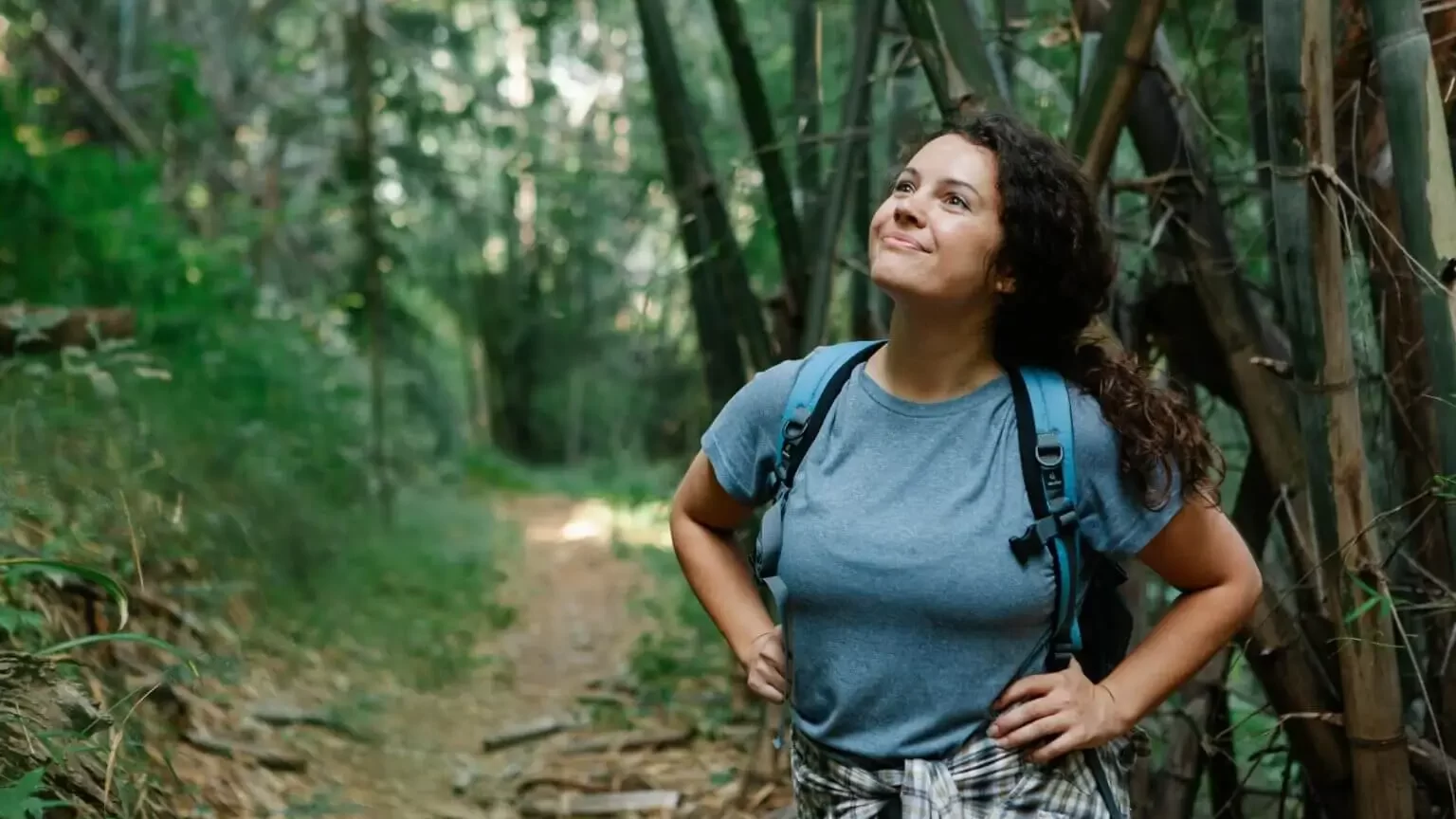
We often hear the advice to “go outside and you’ll feel better.” But when was the last time you stepped outside just to be in the fresh air? Or did you take a leisurely walk just to clear your mind?
All of us are looking for peace and balance in our busy and tech-driven lives. On average, we spend 90% of our time indoors. Our weekly screen time has increased to 28.5 hours a week since the COVID-19 epidemic. And that doesn’t even account for the time many people spend at work in front of their computers. All we need is to break this cycle and indulge some time in the fresh air and clear our minds. That is where nature bathing comes in, a practice that helps to benefit your mind and body.
This article will all be about the origins of forest bathing, its benefits, and how you may make it a part of your routine for better health.
What is Nature Bathing?
Forsest or nature bathing is based on a Japanese practice called Shinrin-Yoku. It was developed in 1982 by the Japanese Ministry of Agriculture, Forestry, and Fisheries as a part of the health program. The original idea was to help people who live in cities and deal with problems like noise pollution, air pollution, high stress, and too much technology use.
The Shinrin-Yoku, which translates to forest therapy in English, is defined as making contact with and taking in the atmosphere of a forest. In other words, you “bathe” in the forest air by focusing on your surroundings and taking in the oxygen and wood oils that the trees give off.
It basically involves the use of all five senses and connecting them to the natural environment. This process of returning to nature can give you a better state of calmness and tranquility.
Science Behind Nature Bathing
By far we know that nature bathing is much more than a guided nature walk and researchers are still learning how it works. However, some of these studies have shown real healing effects from exposure to the natural habitat.
Research has shown that plants and trees give aromatic compounds or essential oils called phytoncides. These natural antimicrobial substances are part of the tree’s immune system. These are also volatile in nature, and inhaling that therapeutic air helps with all the bodily and mental health benefits. In other words, it can also be considered aromatherapy.
Now, let’s look at the research-based benefits of nature bathing in detail.
1. Reduces Stress Levels
Spending time in nature is itself a therapy and in the case of nature bathing, it has even been proven to reduce the stress levels in the body. A study done in Japan proved that leisurely walks in forests reduce the level of stress hormone cortisol by 12.4% as compared to a metropolitan park.
So, if you’re looking to relieve stress and anxiety, going for a walk in the forest is a great place to start.
2. Improves Mental Health
The nature bathing benefits can also be seen for mental health. According to an analysis of various research published in Urban Forestry & Urban Greening, forest bathing may greatly reduce depressive symptoms and increase general happiness. The participants reported feeling calmer, less worried, and overall happier after spending time in the greenery of forests.
This means natural bathing can be a great tool in boosting mental clarity and uplifting your spirits.
3. Enhances Creativity
Nature bath also helps to boost creativity and this fact is also backed by science. Scientific studies have shown that spending as little as three days in nature may significantly improve problem-solving abilities by up to 50%.
It shows that the meditative effect of nature bathing can surely cut the distraction of modern-day life and clear your head.
4. Strengthening Cognitive Skills
While we know the creative benefits of nature bathing, a study done by Stanford University discovered that people’s subgenual prefrontal cortex activity dropped after 90 minutes of walking in a natural setting. This area of the brain is responsible for rumination, a kind of negative, repeated thinking. Rumination has been related to mental health issues, including anxiety and depression.
This research provides more evidence that spending time in nature might enhance concentration and mental clarity.
5. Decreased Blood Pressure
We are all aware of the dangers and effects of hypertension. But the good news here is that time spent in nature or such biotypes significantly increases the parasympathetic nervous system and lowers blood pressure. This in turn helps to reduce the stress response of the body. In another study, spending time in the forest has been found to reduce heart rate by 5-7%!
This goes to show how nature has a very positive effect on the health of the heart and giving it a try is a must.
6. Boosts the Immune System
Taking a bath in nature doesn’t just lift your spirits, it might also give your immune system a powerful boost. And this connection with the natural world could make you less susceptible to illness.
As per research published in the journal Environmental Health and Preventive Medicine, spending time in forests enhances the activity of natural killer (NK) cells. These cells are vital in the body’s fight against infections and cancer. Remarkably, this enhanced immune system lasted for more than a month after the forest visit.
The secret lies in the phytoncides, the aromatic compounds are present in trees. These are the compounds that battle against infections by enhancing the activity of our defense mechanism.
7. Reduces Chances of Obesity and Diabetes
Natural bathing is also a great way to lose weight and fight diabetes. One main factor is its ability to raise adiponectin, a hormone that helps control glucose levels and the breakdown of fatty acids.
In fact, a very interesting study showed that diabetics could significantly lower their blood sugar levels even if they only did forest bathing once every eight months for six years. It means that stepping into the woods isn’t just a relaxing escape, it can also be a meaningful step toward better metabolic health.
8. Speeds Up Recovery After Illness
Like all the other benefits, nature bathing is a powerful ally in speeding up our recovery from illness, as nature acts as a catalyst for the healing process.
It was found in a study that patients who had “green” views had shorter stays in the hospital after surgery, took fewer painkillers, and had fewer compilations. In contrast, those with no view or a view of a cement wall had worse outcomes.
How to do Nature Bathing?
Well, as the name suggests, you don’t necessarily need to venture into deep forests to have the benefits of nature bathing. A visit to the neighborhood park or your favorite hiking route would all be great options. Even research has proven that a person can feel better if they spend their time in an urban park.
Find a Spot
To get started, select a relatively calm area in nature and away from city life. The best time to visit these places is in the early morning or later evening. It is also a good idea to leave your phone and camera at home. Such gadgets can pull you away from the core aim of enjoying nature.
Tune Your Senses
Once you are at the location, center yourself and take a few seconds to observe your immediate environment. If you wish to sit somewhere, take a seat and observe the wind rustling the leaves.
Other simple activities you can do are to use your five senses, such as touching the wood bark and feeling it on your fingers, watching how the sun shines through the leaves, or trying to identify different bird sounds around you.
If you like to stroll, prefer slow and small steps, observing the natural beauty around you. Also, don’t worry about getting there in particular. Just enjoy the journey and the beauty around you. The key is to practice mindfulness, the idea of being in the present.
The best is to dedicate at least 20 minutes each day to nature bathing. But if you do not have that much time on your plate, then beginning with less time is equally OK. Plus, going for a nature bath shouldn’t seem like work because that’s not the point. It ought to be something you eagerly anticipate and appreciate.
Learning Nature Therapy with Expert Guidance
While this is a practice that you can do on your own. But having a guide may be a great asset, especially when you are just starting. These guides are trained by the Association of Nature and Forest Therapy around the globe and can guide you about interesting things and help you mindfully experience all of the forest using all of your senses.
Once you’ve mastered the art of forest therapy, you can practice it in your garden or at a local park and enjoy its benefits whenever you want.
Who Can Do Nature Bathing?
Everyone, regardless of their age or fitness level, is suitable to do forest bathing. Even children can enjoy the benefits offered by nature bathing. But we recommend that adults supervise children while they engage in forest bathing to ensure a safe and enriching experience.
Options for When You Can’t Experience Nature Bathing
If you don’t have the facility to go outside or to nearby parks or trials due to some issue or disability, there are sense-based nature therapy exercises that may be done in the comfort of one’s own home.
You can add houseplants, decorate with nature-themed items, or listen to recordings of soothing nature sounds like water streaming or birdsong. Another thing you can do is to use some virtual reality tours that may make you feel like you are there in a forest.
You can take it a step further by adding essential oil aromatherapy. This will fill your home with uplifting fragrances that evoke the essence of nature.
Conclusion: Embrace the Nature Bathing
Nature bathing isn’t just a pastime. It is indeed a nourishing practice for body and mind. It proves that you may improve your physical and mental health in countless ways just by spending time in nature. So the next time you find yourself in a natural setting, make use of nature’s restorative powers. Just look at the places where there are trees and here you go!
If you find this technique useful, you can always write it in a journal for later reading or share the experiences with friends and family, and maybe they will be inspired to do the same.
So, are you ready to try this mindful practice for better health and well-being? We’d love to hear your thoughts! Share your experiences in the comments below and let’s encourage each other on this journey of natural therapy.
And if you find the benefits of nature bathing interesting, you won’t want to miss our article on How Your Perception May Differ from Reality. Find out how your mind can sometimes change your reality, which can affect your feelings and experience. You might be surprised to read it!
References:
1. Schweizer, Christian, et al. “Indoor time–microenvironment–activity patterns in seven regions of Europe.” Journal of Exposure Science & Environmental Epidemiology, vol. 17, no. 2, May 2006, pp. 170–81. https://doi.org/10.1038/sj.jes.7500490.
2. Hansen, Margaret M., et al. “Shinrin-Yoku (Forest Bathing) and Nature Therapy: A State-of-the-Art Review.” International Journal of Environmental Research and Public Health, vol. 14, no. 8, July 2017, p. 851. https://doi.org/10.3390/ijerph14080851
3. Li, Q., et al. “Effect of Phytoncide from Trees on Human Natural Killer Cell Function.” International Journal of Immunopathology and Pharmacology, vol. 22, no. 4, Oct. 2009, pp. 951–59. https://doi.org/10.1177/039463200902200410.
4.—. “New Concept of Forest Medicine.” Forests, vol. 14, no. 5, May 2023, p. 1024. https://doi.org/10.3390/f14051024.
5. Li, Qing. “Effects of forest environment (Shinrin-yoku/Forest bathing) on health promotion and disease prevention —the Establishment of ‘Forest Medicine’—.” Environmental Health and Preventive Medicine, vol. 27, no. 0, Jan. 2022, p. 43. https://doi.org/10.1265/ehpm.22-00160.
6. Atchley, Ruth Ann, et al. “Creativity in the Wild: Improving Creative Reasoning through Immersion in Natural Settings.” PLoS ONE, vol. 7, no. 12, Dec. 2012, p. e51474. https://doi.org/10.1371/journal.pone.0051474.
7. Bratman, Gregory N., et al. “Nature experience reduces rumination and subgenual prefrontal cortex activation.” Proceedings of the National Academy of Sciences, vol. 112, no. 28, June 2015, pp. 8567–72. https://doi.org/10.1073/pnas.1510459112.
8. Ideno, Yuki, et al. “Blood pressure-lowering effect of Shinrin-yoku (Forest bathing): a systematic review and meta-analysis.” BMC Complementary and Alternative Medicine, vol. 17, no. 1, Aug. 2017, https://doi.org/10.1186/s12906-017-1912-z.
9. Yau, Katherine Ka-Yin, and Alice Yuen Loke. “Effects of forest bathing on pre-hypertensive and hypertensive adults: a review of the literature.” Environmental Health and Preventive Medicine, vol. 25, no. 1, June 2020, https://doi.org/10.1186/s12199-020-00856-7.
10. Li, Q., K. Morimoto, et al. “Visiting a Forest, but Not a City, Increases Human Natural Killer Activity and Expression of Anti-Cancer Proteins.” International Journal of Immunopathology and Pharmacology, vol. 21, no. 1, Jan. 2008, pp. 117–27. https://doi.org/10.1177/039463200802100113.
11. Ohtsuka, Y., et al. “Shinrin-yoku (forest-air bathing and walking) effectively decreases blood glucose levels in diabetic patients.” International Journal of Biometeorology, vol. 41, no. 3, Feb. 1998, pp. 125–27. https://doi.org/10.1007/s004840050064.
12. Mascherek, Anna, et al. “On the relation between a green and bright window view and length of hospital stay in affective disorders.” European Psychiatry, vol. 65, no. 1, Jan. 2022, https://doi.org/10.1192/j.eurpsy.2022.9.
13. Cheng, Yingyi, et al. “Effects of urban parks on residents’ expressed happiness before and during the COVID-19 pandemic.” Landscape and Urban Planning, vol. 212, Aug. 2021, p. 104118. https://doi.org/10.1016/j.landurbplan.2021.104118.
14. “Association of Natural Forest Therapy.” https://anft.earth. anft.earth/listings. Accessed 3 Sept. 2024.



Leave a Reply